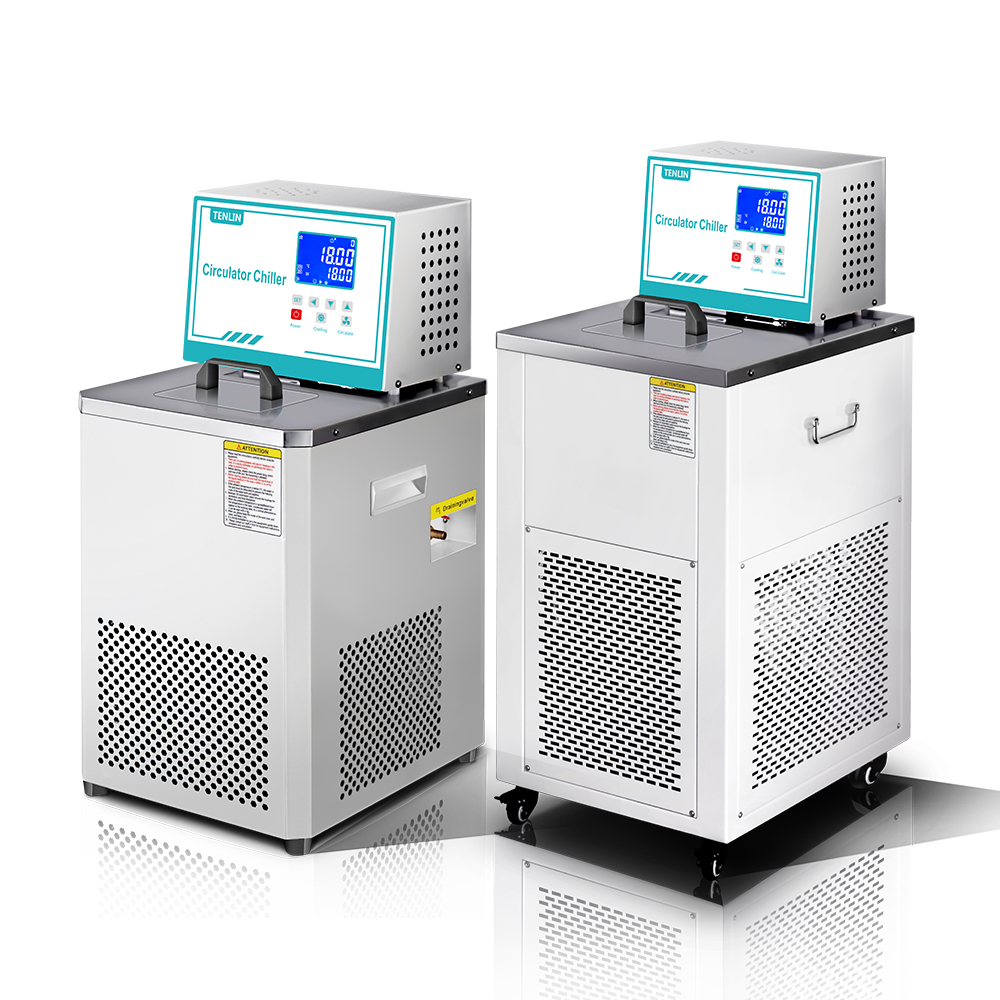Le réservoir d'eau à circulation à basse température constante est un équipement de contrôle de température couramment utilisé en laboratoire. Il sert principalement à maintenir une température basse ou spécifique constante grâce à la circulation d'eau de refroidissement. Largement employé dans divers domaines expérimentaux tels que la chimie, la biologie, les matériaux et la pharmacie, il est particulièrement adapté aux expériences exigeant un contrôle précis de la température. Nous vous présenterons ici plus en détail les principes de base, les principaux cas d'application et les précautions d'emploi des réservoirs d'eau à circulation à basse température constante.
1. Principe de base du bain-marie à circulation de laboratoire :
Le principe de base d'un bain-marie de laboratoire est d'abaisser la température de l'eau grâce à un système de refroidissement et de la maintenir à la température de consigne. Le fluide caloporteur contenu dans le bain est refroidi par un groupe frigorifique, puis acheminé vers l'appareil nécessitant un contrôle de température par une pompe de circulation. Il circule ainsi en continu afin de garantir la stabilité de l'ensemble du système à la température de consigne.
Un bain-marie à circulation typique de laboratoire comporte les composants clés suivants :
Système de réfrigération :Il comprend généralement un compresseur, un condenseur et un évaporateur, utilisés pour abaisser la température du fluide frigorigène.
Pompe de circulation :Acheminer le liquide de refroidissement vers le dispositif expérimental et renvoyer le liquide refroidi dans le réservoir d'eau pour assurer la circulation.
Système de contrôle de la température :utilisation de la régulation PID et d'autres technologies pour contrôler avec précision la température à l'intérieur du réservoir d'eau et maintenir des conditions expérimentales stables.
Évier et canalisation :Le liquide de refroidissement contenu dans l'évier circule en continu pendant l'expérience, et la canalisation sert à transporter ce liquide jusqu'au dispositif expérimental qui nécessite un contrôle de la température.
2. Principaux scénarios d'application des réservoirs d'eau à circulation à température constante basse température :
Refroidissement des équipements à haute température :
Dans certains procédés expérimentaux à haute température, tels que le chauffage de réacteurs ou d'évaporateurs rotatifs, des réservoirs d'eau à circulation à température constante et basse température peuvent refroidir rapidement l'équipement, empêcher une température excessive d'affecter les résultats expérimentaux et prolonger la durée de vie de l'équipement.
Réacteur chimique de refroidissement :
Lors des réactions chimiques, la température influe considérablement sur des facteurs tels que la vitesse de réaction, la sélectivité et le rendement. Le réservoir d'eau à circulation à température constante et basse température permet de réguler précisément la température du réacteur, assurant ainsi un contrôle rigoureux du processus de réaction chimique.
Environnement de culture à basse température :
Dans les expériences biologiques, on utilise couramment des réservoirs d'eau à circulation à température constante basse température pour la culture à basse température, notamment pour la culture de micro-organismes ou de cellules ayant des exigences de température strictes, afin de garantir que les sujets expérimentaux se développent à la température optimale et d'éviter les variations causées par les fluctuations de température.
Assistance au contrôle de la température pour les instruments de précision :
Certains instruments de précision, tels que les microscopes électroniques et les spectromètres, génèrent de la chaleur en fonctionnement, ce qui affecte leur stabilité. L'utilisation d'un réservoir d'eau à circulation d'eau à basse température constante permet de réguler la température et de garantir la stabilité de l'instrument ainsi que la précision des mesures.
Essais de matériaux et recherche sur les propriétés physiques :
Le coefficient de dilatation thermique, la conductivité thermique, la résistance et les autres propriétés physiques des matériaux sont généralement étroitement liés à la température. Un bain à circulation d'eau à température constante à basse température permet de réaliser des essais dans différentes conditions de température, aidant ainsi les chercheurs à étudier le comportement des matériaux à différentes températures.
3. Précautions d'utilisation d'un réservoir d'eau à circulation à température constante basse température :
Choix du liquide de refroidissement :
Choisissez le fluide de refroidissement approprié en fonction des exigences expérimentales ; les fluides de refroidissement couramment utilisés comprennent l’eau pure, une solution d’éthylène glycol, etc. Il convient de noter que la viscosité, la conductivité thermique et la corrosivité du fluide de refroidissement envers les matériaux de l’équipement peuvent avoir un impact sur l’expérience.
Entretien et nettoyage réguliers :
Le liquide de refroidissement de l'évier doit être remplacé régulièrement afin d'éviter le dépôt d'impuretés qui pourraient nuire à son efficacité. Parallèlement, le condenseur, la pompe de circulation et les autres composants de l'appareil doivent être inspectés et entretenus régulièrement pour garantir son bon fonctionnement.
Réglages de contrôle de la température :
Lors du réglage de la température, il est impératif de respecter les exigences expérimentales afin de ne pas dépasser la plage de contrôle de température de l'équipement, et ainsi éviter tout dommage matériel ou tout échec expérimental. Par ailleurs, un refroidissement ou un chauffage trop rapide peut avoir des effets néfastes sur certaines expériences ; il convient donc de privilégier une courbe de régulation de température progressive.
Fonctionnement sûr :
Lors de l'utilisation d'un réservoir d'eau à circulation à température constante basse température, il est impératif d'éviter tout contact direct avec le liquide de refroidissement froid afin de prévenir les gelures. Pendant l'expérience, l'équipement doit être placé dans un endroit bien ventilé pour éviter que les températures élevées ou la lumière directe du soleil ne l'endommagent.
4. Résumé :
Les bains-marie thermostatés à circulation jouent un rôle indispensable dans les expériences modernes, garantissant un contrôle précis de la température et une stabilité expérimentale optimale. Qu'il s'agisse de refroidir des réactions chimiques, de cultiver des échantillons biologiques à basse température ou de réguler la température d'instruments de précision, les bains-marie à circulation d'eau à température constante répondent efficacement aux besoins expérimentaux et facilitent le travail des chercheurs.

Date de publication : 5 novembre 2024






